“I found some!” I hear Ranger Laura shout as she points down at the knee deep water. She takes a long-handle net and carefully dips a white jelly mass from beneath the surface. Ranger Kirk wades up behind her and confirms “Yep – you’ve found salamander eggs.” He gently picks them up from the net and transfers them to a clear container so we all can see.
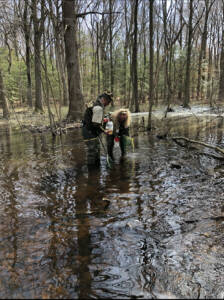 This has always been one of my favorite parts of my job as a Naturalist – learning out in the field. This excursion took Cromwell Valley Park’s Naturalists to a large vernal pond one cool day in the middle of March. We searched in and around its murky waters for the different lifecycle stages of the Yellow Spotted Salamander. It did not disappoint.
This has always been one of my favorite parts of my job as a Naturalist – learning out in the field. This excursion took Cromwell Valley Park’s Naturalists to a large vernal pond one cool day in the middle of March. We searched in and around its murky waters for the different lifecycle stages of the Yellow Spotted Salamander. It did not disappoint.
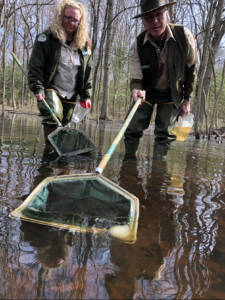
Vernal ponds get their name from the Latin word ver meaning “spring”. This seems appropriate since these habitats fill with water and come to life during the springtime. As the heat of summer sets in though, the water dries up. Because of this, vernal ponds normally lack fish – which is great news for the creatures which call it home! Vernal pond dwellers include our local amphibian populations, such as Wood Frogs, Spring Peepers, American Toads, Yellow Spotted Salamanders, and Grey Tree Frogs, who use the shallow waters to mate and breed. The ponds fill with thousands of eggs all laid in clumps and masses which, once hatched, would become the perfect snack for predatory fish if they were present. This makes vernal ponds an absolutely essential part of Maryland’s ecology and a truly important factor in the state’s biodiversity.
“Someone bring a container!”, Ranger Laura and I hear from a distance. We pick our way through the wetland area, over logs and around shrubs, to find the Park Director and Senior Naturalist, Ranger Kirk, bent over and staring hard at the tea-colored water. I hold out the requested plastic container. He very slowly brings his hands to the top of the water and then in one quick move, cups something from below the surface. He plops his find into the container. “Salamander larvae!” he exclaims as Laura and I stare at a small green and brown creature about 2 inches long.
Even though yellow spotted salamander larvae vaguely resemble tadpoles, or baby frogs, Ranger Kirk points out a key difference in appearance. Baby salamanders have feathery, external gills on the sides of their head while tadpoles only have gill slits which can be hard to see. As salamander larvae grow up they go through metamorphosis. During this process they get bigger, their tail becomes less paddle-like and they turn black with bright yellow spots appearing along their backs. What is the most remarkable change during this period though? They grow lungs! Their external gills are absorbed back into their bodies and the structure of their respiratory system changes. As the waters of the vernal pools recede, these amphibians will now have the ability to survive outside their aquatic nursery and live on land.
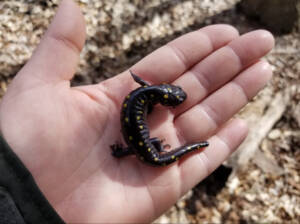
Which leads Ranger Kirk to suggest we start prying up a few small logs to see if we can catch a glimpse of an adult salamander. He points to a moist-looking piece of wood at my feet. “There is one under that log Ranger B”, he teases. Trying to hold in a smirk, I gently tip the wood back towards me, and my expression quickly changes. “There is!”, I shout. Rangers Kirk and Laura come running over in surprise. Lying in the soft dirt is a jet black salamander with yellow dots that look like they were applied with a paint brush.

All three of us were excited now and we spread out to search under more forest debris. It must have been my lucky day, because under the next log I turned over, there was a marbled salamander staring back at me! I was dumbfounded. I don’t want to give the reader the impression that this is typical. Salamanders are generally rather elusive, especially these two types of mole salamanders, who both spend a good portion of the year burrowed in the ground. The moment was significant for me, and perhaps Rangers Kirk and Laura as well, because all three of us were seeing a marbled salamander living wild in its natural habitat for the very first time. It was a great way to end the day.
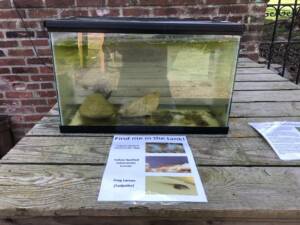 This week we are waiting for the salamander egg mass to hatch, which we brought back to the Willow Grove Nature Center. Please note that we are able to collect these amphibian eggs for educational purposes in accordance with a permit we hold with Maryland’s Department of Natural Resources. They are on display for all park visitors to see and enjoy. Because the nature center is closed at this time, you can find the salamander tank on the brick patio outside the building. We hope you stop by and take a peek!
This week we are waiting for the salamander egg mass to hatch, which we brought back to the Willow Grove Nature Center. Please note that we are able to collect these amphibian eggs for educational purposes in accordance with a permit we hold with Maryland’s Department of Natural Resources. They are on display for all park visitors to see and enjoy. Because the nature center is closed at this time, you can find the salamander tank on the brick patio outside the building. We hope you stop by and take a peek!
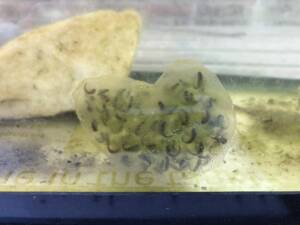
— Ranger B

